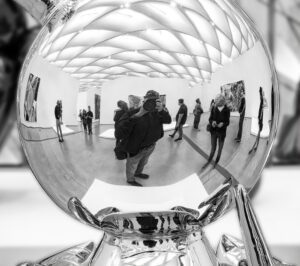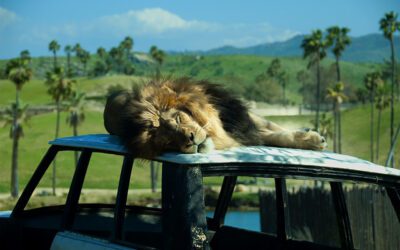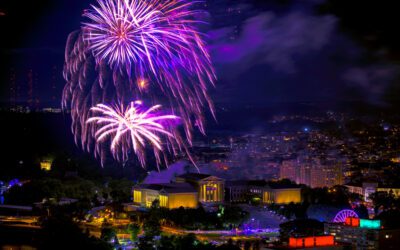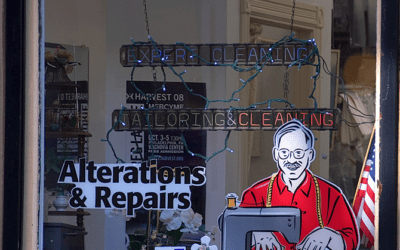A recent study concludes that a selfie death is a public health issue and tourists are at the center of selfie accidents, many fatal.

Self portrait on the face of the Jeff Koons’ Rabbit at The Broad museum of contemporary art, Los Angeles. Copyright © 2022 NSL Photography. All Rights Reserved.
According to the Global “Death by Selfie” Database, as of July, 2023, there have been 14 deaths world-wide each categorized as a selfie death this year.
There were 30 selfie deaths in 2022, 33 in 2021, 8 in 2020 during the height of the Covid pandemic and 19 in 2019. India has the most selfie deaths, with the United States coming in next.
Since 2019 there have been more than 100 selfie deaths world-wide.
Some examples of a fatal selfie death and a near fatal selfie incidents in recent years include:
• Earlier this year, a 42-year-old female passenger on Royal Caribbean’s Mariner of the Seas fell overboard while sitting on a railing attempting to make a selfie. The U.S. resident somehow survived the 10–story fall and was rescued about 45 minutes later. She was lucky, very lucky.
• A 43-year-old female tourist at Yellowstone National Park posed just six yards from a bison for a selfie with her daughter when the bison charged, flipping her into the air with its head. Somehow she survived.
• In Peru, a man fell to his death while posing for a picture on a ledge at Machu Picchu.
• During the “Running with the Bulls,” in Pamplona, Spain, a man left the audience-protected area to capture a selfie in front of two bulls about to collide. A third bull ran into him from behind and fatally gored his neck and thigh.
• An Israeli teenager fell to his death while taking a selfie at Yosemite National Park. A month later at Yosemite, an Indian couple fell to their deaths taking a selfie.
• A Polish couple’s two young children watched in horror as their parents climbed over the safety barrier and fell to their deaths while taking a selfie on a cliff in Cabo da Roca, Portugal.
If you’re not sure what a selfie is, it’s a photograph or video that’s made by and of oneself, perhaps with others in it, generally made with a smartphone held at arm’s length or with the aid of a pole (selfie-stick) on which the smartphone is mounted.
Most selfies are made safely, but far too many are made after caution and commonsense have been discarded. The it results in a selfie death.
You’ve probably seen hundreds or maybe thousands of selfies made. They are generally made with the intent of sharing them on social media. Made during special occasions and at ordinary times, plus definitely during travel, these photos often to show off travelers’ destinations. They’re mostly made safely, but far too often, they’re made with caution thrown aside.
Years ago, they were called self-portraits. People have been making selfies for more than 33 centuries. Archaeologists discovered a selfie made in 1365 BCE by Pharaoh Akhenaten’s chief sculptor Bak. The great Dutch painter Rembrandt van Rijn is the all-time king of the selfie. During the first half of the nineteenth century, selfies became a photographic staple. Robert Cornelius, a life-long Philadelphian, is reputed to have made the first photographic selfie in 1839.
Smartphones have made it easy to make selfies and for some, social media has created a world-wide competition to make the best selfie, no matter how dangerous.
Today, the smartphone has boosted the ability of travelers and others to make selfies. Coupled with the popularity of social media, the problem of “death by selfie” has been rising everywhere. Among too many, posting the best selfie has turned into a world-wide competition for social media photo junkies. “Selfie mania” has pushed otherwise mature, smart people to throw away their commonsense and put themselves unnecessarily into high-risk situations. Far too often it’s resulted in serious injury or death.
A study, Selfie-Related Incidents: Narrative Review and Media Content Analysis, published in March by Australian researchers, concludes that selfie-related deaths, particularly falls from significant heights and drowning, are a public health issue.
Nathalie Auger, MD, MSc, a physician epidemiologist at the University of Montreal Hospital Research Centre in Canada, who has been researching the phenomenon herself, discussed the study with Medpage Today.
“Selfie-related mortality is a public health concern as these deaths affect people of all ages around the world, have been increasing, and could be prevented through better public education and awareness.”
Young people may be more at risk for making dangerous selfies.
She said that her own research showed that young people are particularly at risk and might not understand the risk involved with taking a “daring selfie.”
I’ve safely been making selfies for years. They’re an important part of my repertoire. They’re fun, and can be highly expressive for photographers of any ability. The image above is a self-portrait I made last year in the face of Jeff Koon’s “Rabbit” sculpture at the Broad Museum of Contemporary Art in Los Angeles.
Selfies are sought-after mementos for travelers to capture precious memories to share with friends and family.
For travelers, perhaps more than for other people, selfies capture precious memories they can review for a lifetime and share with friends and family. Unfortunately, however, getting the greatest selfie ever has pushed some people beyond a state of reason.
Making selfies by unthinking people has damaged precious art works.

A few months ago, a German tourist climbed up on the iconic Fountain of Neptune to make a selfie. The incident happened in Florence’s Piazza della Signoria. When he came down he knocked off a chunk of marble from Neptune’s chariot and cracked one of the horse’s hoofs.
I don’t think anyone with a love of art will forget the pair of tourists who knocked off a portion of the Two Hercules (circa 1700) Cremona sculpture crown, shattering it when it hit the ground, or the Italian student who jumped into the lap of the Drunken Satyr to make a selfie and broke off its leg, smashing it into many pieces at Milan’s Academy of Fine Arts of Brera.
Making selfies by feckless people has put third persons into serious danger.
Then there is unreasonable selfie behavior seriously endangering innocent third persons. In Venice, taking a gondola ride in the canals, Chinese tourists refusing to follow the gondolier’s instruction to sit down, while attempting to take a selfie, capsized the gondola, sending everyone into the cold water. Fortunately, no one was killed, but only by pure luck.
It’s time for tourists and others to use their commonsense and intelligence when making selfies.
My three selfie rules of conduct.
Here are my three selfie rules of conduct and self-preservation.
1. Respect others’ safety: It’s bad enough to stupidly put yourself in danger by selfie. It’s unconscionable to endanger others.
2. Respect for wildlife: Respect for wildlife is two-fold. First, be careful not to be hurt by wildlife. Second, be careful not to hurt wildlife or their habit so everyone can continue to enjoy seeing and studying them.

Respect can keep oneself alive and well while making great selfies.
READ ALSO:
Six Christmas dreams for travelers in 2024
My 13 top hotel peeves that can ruin your hotel stay
After many years working in corporate America as a chemical engineer, executive and eventually CFO of a multinational manufacturer, Ned founded a tech consulting company and later restarted NSL Photography, his photography business. Before entering the corporate world, Ned worked as a Public Health Engineer for the Philadelphia Department of Public Health. As a well known corporate, travel and wildlife photographer, Ned travels the world writing about travel and photography, as well as running photography workshops, seminars and photowalks. Visit Ned’s Photography Blog and Galleries.



